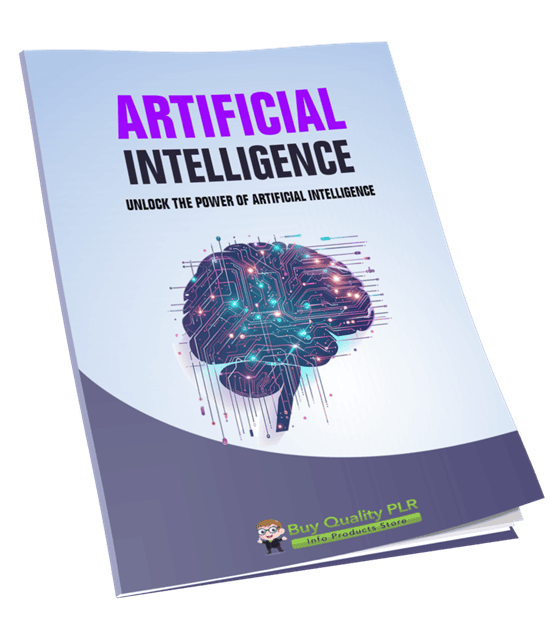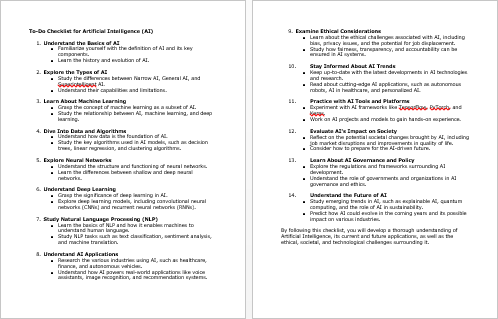
Artificial Intelligence PLR Course 30k Words
in Artificial intelligence PLR , Artificial Intelligence PLR eBooks , PLR Checklists , PLR eBooks , PLR eCourses , PLR List Building Reports , Premium PLR , Premium PLR eBooks , Premium PLR Reports , Premium White Label Brandable PLR Coaching Courses , Private Label Rights ProductsChoose Your Desired Option(s)
has been added to your cart!
have been added to your cart!
#artificialintelligence #plrcourse #aimarketing #digitalbusiness #aiforbeginners #techtrends #onlineincome #aitraining #plrcontent
Unlock the Power of Artificial Intelligence with Our Done-for-You PLR Course!
Are you ready to dive into the world of Artificial Intelligence (AI)? Whether you’re looking to build a profitable AI-related business or simply expand your knowledge on one of the most innovative technologies of our time, our Artificial Intelligence PLR Course is the perfect resource for you!
Get instant access to this comprehensive course for only $14.99 and equip yourself with the tools and knowledge needed to understand AI, machine learning, natural language processing, and more! This PLR course is a goldmine for bloggers, educators, entrepreneurs, and anyone looking to create valuable content in the AI space.
Presenting…
Artificial Intelligence PLR Course 30k Words
What’s Included in the Artificial Intelligence PLR Course?
Module 1: Introduction to Artificial Intelligence
- What is Artificial Intelligence?: Understand the basics of AI and its evolution.
- Types of AI: Dive into the differences between Narrow AI, General AI, and Superintelligence.
- Key Components of AI: Learn the foundational technologies of AI like Machine Learning, Neural Networks, and Natural Language Processing (NLP).
- The Role of Data in AI: Explore how data fuels AI systems and why it’s crucial for accuracy.
Module 2: Machine Learning Basics
- Understanding Machine Learning: A breakdown of how AI systems learn from data to make decisions.
- Types of Machine Learning: Explore Supervised Learning, Unsupervised Learning, and Reinforcement Learning.
- The ML Workflow: A detailed look at the steps in creating machine learning models, from data collection to model evaluation.
- Algorithms in Machine Learning: Learn about the common algorithms used in ML, including Decision Trees, Linear Regression, and K-Means Clustering.
Module 3: Deep Learning and Neural Networks
- Introduction to Deep Learning: Learn why deep learning is essential for handling large datasets like images and speech.
- Neural Networks Explained: Understand how neural networks mimic the human brain to process information.
- Types of Neural Networks: Get familiar with different types of neural networks like CNNs for image recognition and RNNs for sequential data like text.
- Training Deep Learning Models: Explore how deep learning models are trained using backpropagation, optimization, and loss functions.
Module 4: Natural Language Processing (NLP)
- What is NLP?: Discover how NLP enables machines to understand and generate human language.
- Text Preprocessing in NLP: Learn the key techniques like tokenization and stop-word removal to prepare text for NLP tasks.
- NLP Models and Algorithms: Dive into NLP algorithms like Bag-of-Words, TF-IDF, and Word2Vec.
- Applications of NLP: See how NLP is transforming industries through applications like sentiment analysis, language translation, and more.
Module 5: Ethics and the Future of AI
- Understanding AI Ethics: Discuss the ethical considerations of AI, including bias, privacy, and potential job displacement.
- Ensuring Fairness in AI: Learn how AI systems can be made more fair and transparent.
- The Future of Artificial Intelligence: Explore the exciting possibilities of AI, from autonomous vehicles to personalized healthcare.
- Preparing for an AI-Driven World: Understand how AI will impact industries and how to stay ahead in an AI-powered future.
Bonus Features in Your Artificial Intelligence PLR Course
1. Artificial Intelligence Checklist – 468 Words
This handy AI checklist will help you break down AI concepts into bite-sized, actionable steps for better comprehension and learning.
2. Artificial Intelligence FAQs – 1079 Words
Provide value with an FAQ page that addresses common questions related to AI. This ready-to-use content will save you time and enhance your audience’s learning experience.
3. Sales Page – 731 Words
A professionally written sales page designed to help you sell the course, complete with persuasive language and a clear call to action.
How to Use and Profit from This Artificial Intelligence PLR Course
Our done-for-you AI course offers limitless potential to help you grow your business and reach new audiences. Here are just a few ideas for how you can profit:
1. Sell the Content As-Is
You can sell the entire course directly to your audience. The Artificial Intelligence PLR course provides everything they need to understand AI and its applications, all in one package.
2. Break the Course into Individual Reports
Segment the course into smaller reports for sale at $10-$20 each. By breaking the course up, you can target different segments of your audience, from beginners to advanced learners.
3. Bundle with Other Content
Combine this course with other related content (e.g., tech, digital marketing, or business automation) to create a larger product bundle. This could be sold for $47-$97, increasing your earning potential.
4. Set Up a Membership Site
Turn the course into a membership site, where you offer regular updates on AI, tutorials, and case studies. Generate recurring income by offering a monthly subscription.
5. Create a Multi-Week E-Class
Convert this course into a multi-week e-class and charge $297-$497 for access. Add quizzes, assignments, and live Q&A sessions for even more value.
6. Offer as a Physical Product
Use the Artificial Intelligence PLR course to create a physical product like a printed workbook or a training manual and sell it for a premium price.
7. Use as Lead Magnets
Give away snippets or chapters of the course for free as lead magnets to grow your email list. Once you’ve built your audience, you can sell the full course or related products.
License Terms – What You Can and Can’t Do
What You Can Do:
- Sell the content as-is or with minor tweaks.
- Break it into smaller, individual reports for $10-$20 each.
- Bundle the course with other content to create larger products for $47-$97.
- Set up a membership site and generate residual income.
- Convert the content into a multi-week e-class for $297-$497.
- Create physical products (e.g., workbooks or guides) and sell them.
- Use it as a lead magnet to grow your email list.
What You Can’t Do:
- Pass on PLR rights to your customers.
- Offer 100% affiliate commissions (maximum 75%).
- Give the complete content away for free—they must be sold.
- Add this content to any existing customer orders unless they make an additional purchase.
Get Started Today for Just $14.99!
Don’t miss out on this incredible opportunity to leverage the power of Artificial Intelligence! For only $14.99, you’ll receive 28574 words of high-quality PLR content, plus bonus materials like checklists, FAQs, and a sales page. This done-for-you course will save you time and help you make money in the booming AI industry.
Grow Your Business with AI Today
The Artificial Intelligence PLR Course is a game-changer for anyone looking to tap into one of the most exciting and profitable industries of our time. With step-by-step modules and done-for-you content, you can jump-start your AI business and provide real value to your audience.
Get your copy of the AI course now and take the first step toward success in the AI-driven future!
has been added to your cart!
have been added to your cart!
Here A Sample of Artificial Intelligence PLR Course
Module 1: Introduction to Artificial Intelligence
Step 1: What is Artificial Intelligence?
In this first step, we will explore the fundamental concept of Artificial Intelligence (AI), shedding light on its purpose, capabilities, and impact on society. Whether you’re an entrepreneur, educator, or a course creator, having a clear understanding of AI’s origins and evolution is essential to contextualize its present and future potential. AI is not just a buzzword, but a field of study and a driving force in technological advancements.
1.1 Defining Artificial Intelligence
At its core, Artificial Intelligence (AI) refers to the simulation of human intelligence in machines that are programmed to think, learn, and problem-solve like humans. These systems are designed to perform tasks that typically require human intelligence, such as decision-making, pattern recognition, language translation, and even creativity.
AI can be thought of as an umbrella term that includes various subfields and techniques. The two main types of AI that are commonly discussed are:
- Narrow AI (Weak AI): This form of AI is designed to handle a specific task, such as facial recognition or recommendation systems. It is the most common form of AI in use today. While it performs well in its designated function, it does not possess general intelligence or the ability to perform tasks beyond its programming.
- General AI (Strong AI): This is a hypothetical form of AI that possesses the ability to understand, learn, and apply intelligence across a wide range of tasks, similar to human cognitive abilities. General AI remains a future goal and is still a topic of ongoing research and development.
As course creators, it is essential to differentiate these types of AI, as they have distinct capabilities and limitations. Narrow AI powers much of today’s applications, while General AI remains an aspirational goal for the future.
1.2 The History of Artificial Intelligence
AI is not a new concept. Its roots stretch back thousands of years, but modern AI as we know it today has evolved significantly over the past century. Let’s look at some key historical milestones:
- Ancient Beginnings: The concept of machines mimicking human behavior has existed for centuries. In Greek mythology, for instance, the idea of intelligent automatons was represented through stories like the mechanical servant Talos. However, the modern understanding of AI began much later.
- The 1950s: The Birth of AI Theory The 1950s marked the formal beginnings of AI as a field of study. British mathematician and computer scientist Alan Turing proposed the “Turing Test” in 1950, a test designed to assess whether a machine could exhibit intelligent behavior indistinguishable from that of a human. Turing’s work laid the foundation for AI’s theoretical framework.
In 1956, the term “Artificial Intelligence” was coined at the Dartmouth Conference, where scientists like John McCarthy, Marvin Minsky, Nathaniel Rochester, and Claude Shannon proposed a study of how machines could simulate human thinking. This event is widely considered the birth of AI as an academic discipline.
- The 1960s–1970s: Early Progress and Challenges In the 1960s, AI researchers developed the first AI programs, such as ELIZA, an early chatbot designed to simulate conversation with a human. The early years of AI research focused on symbolic AI—programming computers to use rules and logic to mimic human problem-solving.
However, AI development faced challenges in the 1970s, as systems struggled with complexity and scalability. Limited computational power and inadequate understanding of cognitive processes hindered progress during this period, often referred to as the “AI Winter,” when funding and interest in AI research declined.
- The 1980s: Knowledge-Based Systems and Expert Systems The 1980s saw a resurgence in AI research with the development of expert systems, which utilized knowledge-based techniques to simulate decision-making. These systems were programmed with domain-specific knowledge and were used in fields like medicine and finance. Expert systems were seen as a practical application of AI that could handle specialized tasks.
Additionally, this era saw the growth of machine learning (ML) techniques, a subset of AI that focuses on training machines to learn from data rather than being explicitly programmed. This would become a significant breakthrough in AI development.
- The 1990s–2000s: Machine Learning and Data-Driven AI As computing power increased and data became more accessible, AI research shifted toward machine learning and data-driven approaches. In the 1990s, AI systems began to show impressive capabilities in tasks like image recognition, language processing, and game playing.
In 1997, IBM’s Deep Blue famously defeated world chess champion Garry Kasparov, a landmark event in AI history. This victory demonstrated AI’s ability to perform complex calculations and problem-solving at superhuman speeds.
- 2010s–Present: Deep Learning and AI in Everyday Life The 2010s marked a major turning point in AI with the advent of deep learning, a subset of machine learning that uses neural networks to model and understand complex patterns. This breakthrough has enabled AI to perform tasks with human-like proficiency, such as image recognition, natural language processing, and even creating art.
Today, AI is embedded in various aspects of our daily lives, from virtual assistants like Siri and Alexa, to recommendation algorithms on streaming platforms like Netflix and YouTube, to autonomous vehicles developed by companies like Tesla. AI is now an integral part of numerous industries, including healthcare, finance, retail, education, and more.
1.3 How AI Mimics Human Intelligence
Artificial Intelligence is designed to emulate human cognitive functions. But how exactly does AI mimic human intelligence? Here are a few ways it achieves this:
- Learning: Just like humans, AI systems can “learn” from data. In supervised learning, for example, AI models are trained on labeled datasets, much like a student learning from a teacher. Over time, the system improves its ability to make predictions or decisions based on that data.
- Reasoning: AI systems are programmed to apply logic and rules to make decisions. For instance, rule-based systems in AI can evaluate conditions and derive conclusions based on predefined logic, similar to human reasoning in structured environments.
- Perception: AI mimics human sensory perception using technologies like computer vision (recognizing images and videos), speech recognition (understanding spoken language), and natural language processing (interpreting and generating text). These technologies allow machines to perceive their environment in a way similar to humans.
- Problem Solving: AI is also designed to solve problems. Whether through optimization algorithms, decision trees, or game-playing techniques, AI models can identify and solve complex problems, sometimes even surpassing human performance in specific domains.
1.4 The Evolution of AI Over Time
Artificial Intelligence has come a long way since its inception. The evolution of AI has been shaped by advances in computational power, data availability, and machine learning techniques. We have moved from rudimentary systems that required explicit programming to sophisticated models capable of learning, adapting, and even generating new insights.
Looking forward, the field of AI continues to evolve, with exciting breakthroughs in areas like reinforcement learning, natural language understanding, and autonomous systems. As AI progresses, its potential to enhance our lives and transform industries is limitless, offering immense opportunities for course creators and professionals to explore new applications and solutions.
Key Takeaways for Course Creators:
- Understand AI’s history: Knowing where AI has come from will give you a better understanding of its potential and limitations.
- Focus on key AI concepts: As you develop your courses, emphasize the distinction between Narrow AI and General AI, as well as the importance of data in AI.
- Recognize AI’s evolution: The past few decades have been transformative for AI. Today, AI is revolutionizing industries like healthcare, education, and retail, providing plenty of opportunities for innovation and new course creation.
By the end of this step, you should have a foundational understanding of what AI is, how it evolved, and how it is mimicking human intelligence. These insights will serve as the basis for deeper exploration in the following steps of this course.
Does this detailed guide help in understanding the concept of AI? Let me know if you’d like to further elaborate on any specific area!
Step 2: Types of Artificial Intelligence
In this step, we will delve into the three primary types of Artificial Intelligence (AI): Narrow AI, General AI, and Superintelligence. By the end of this section, you will gain a thorough understanding of the distinctions between these AI types, their characteristics, and their real-world applications. This foundational knowledge will equip you, as a course creator, with the ability to explain the range of AI capabilities and potential in your courses.
2.1 Understanding Narrow AI (Weak AI)
Narrow AI, also known as Weak AI, is the most common form of AI used today. This type of AI is designed to perform a specific task or set of tasks. Unlike General AI, which aims to mimic human-like reasoning across various domains, Narrow AI is confined to a particular problem-solving area and excels at that task.
- Characteristics of Narrow AI:
- Narrow AI is highly specialized. It is designed and trained to handle a specific task, and it operates within a limited scope.
- These AI systems don’t have self-awareness or understanding; they simply perform functions based on the data and programming they have received.
- It cannot think outside its designated function or adapt to tasks it was not explicitly programmed to address.
- Examples and Applications of Narrow AI: Narrow AI is widespread in today’s technology landscape, and you interact with it daily, often without realizing it. Some of the most common examples include:
- Virtual Assistants (e.g., Siri, Alexa, Google Assistant): These are AI systems that specialize in speech recognition, language processing, and carrying out specific tasks, such as setting reminders, playing music, or providing weather updates.
- Recommendation Systems (e.g., Netflix, Amazon, Spotify): These AI systems analyze your preferences and past behavior to recommend products, movies, or music tailored to your tastes.
- Image Recognition (e.g., Face Recognition in Social Media, Security Systems): Narrow AI is used to identify faces or objects in images and videos by matching them to pre-existing patterns in its database.
- Autonomous Vehicles (e.g., Tesla’s Autopilot): Narrow AI systems are responsible for tasks such as object detection, path planning, and decision-making for navigation, but they are limited to the context of driving and cannot perform tasks outside that domain.
- Virtual Assistants (e.g., Siri, Alexa, Google Assistant): These are AI systems that specialize in speech recognition, language processing, and carrying out specific tasks, such as setting reminders, playing music, or providing weather updates.
As a course creator, you will need to emphasize that Narrow AI systems are extremely efficient and powerful in their specific applications but cannot generalize their learning beyond those tasks.
2.2 Exploring General AI (Strong AI)
General AI, also known as Strong AI, is a type of artificial intelligence that aims to replicate human-like cognitive abilities in machines. While Narrow AI is focused on specific tasks, General AI has the potential to perform any intellectual task that a human can. It is more flexible and adaptive than Narrow AI, with the capability to learn from different types of experiences and apply that learning to new problems.
- Characteristics of General AI:
- Learning across domains: Unlike Narrow AI, General AI is not restricted to a single area of expertise. It can learn and adapt across multiple domains, allowing it to perform a variety of tasks.
- Problem-solving and reasoning: General AI is expected to reason through complex problems, use logic, make decisions, and understand nuances, similar to human intelligence.
- Emulating human cognition: It will have the ability to perceive the environment, process sensory data, understand natural language, and interact in a human-like manner, making decisions based on emotions, experiences, and context.
- Learning across domains: Unlike Narrow AI, General AI is not restricted to a single area of expertise. It can learn and adapt across multiple domains, allowing it to perform a variety of tasks.
- Current Status and Challenges of General AI: While General AI holds immense potential, it is still theoretical and does not exist in practice as of now. Research in General AI has been ongoing for decades, but the complexity of mimicking human cognition is a significant challenge. There are several reasons why General AI is not yet realized:
- Complexity of Human Intelligence: The human brain’s capabilities are far more intricate than current AI models can replicate. Tasks such as empathy, understanding abstract concepts, and making judgments based on incomplete information remain difficult to model.
- Computational Limitations: Although computational power has grown exponentially, it is still insufficient to replicate the full range of human cognitive functions.
- Ethical and Safety Concerns: The development of General AI presents significant ethical challenges. For instance, if General AI is able to think and reason like humans, it may need rights or protections, and its actions could raise safety concerns in real-world applications.
- Complexity of Human Intelligence: The human brain’s capabilities are far more intricate than current AI models can replicate. Tasks such as empathy, understanding abstract concepts, and making judgments based on incomplete information remain difficult to model.
- Examples of General AI in Fiction: While there are no real-world examples of General AI yet, popular culture often portrays it in science fiction. For example, characters like HAL 9000 from 2001: A Space Odyssey or Data from Star Trek depict machines that possess human-like reasoning and emotions, though they remain works of fiction.
2.3 Introducing Superintelligence
Superintelligence refers to a level of intelligence that surpasses the most brilliant human minds in every aspect. While General AI is still in the realm of theory, Superintelligence represents an even more advanced stage of AI that would excel far beyond human capabilities in reasoning, problem-solving, creativity, and emotional intelligence.
- Characteristics of Superintelligence:
- Unprecedented Problem-Solving Power: A Superintelligent AI would be able to solve complex problems and tasks at speeds and with accuracy far greater than that of any human. It could work across multiple domains simultaneously, revolutionizing fields like medicine, space exploration, and environmental science.
- Self-improvement: Superintelligence could potentially evolve autonomously, improving its own algorithms, learning from its own experiences, and continuously advancing its capabilities without human intervention.
- Control and Autonomy: A Superintelligent system would likely have the ability to make decisions on a global scale, potentially managing the world’s resources, economic systems, and political strategies. This brings significant ethical and regulatory challenges, including the need to ensure that its actions align with humanity’s best interests.
- Unprecedented Problem-Solving Power: A Superintelligent AI would be able to solve complex problems and tasks at speeds and with accuracy far greater than that of any human. It could work across multiple domains simultaneously, revolutionizing fields like medicine, space exploration, and environmental science.
- Potential Applications and Concerns of Superintelligence: While Superintelligence is a futuristic concept, its potential applications are vast:
- Scientific Discovery: A Superintelligent AI could uncover new scientific laws, solve unsolved problems, and dramatically accelerate technological progress.
- Global Management: It could be used to optimize global systems, including healthcare, energy, and even governance, by processing vast amounts of data and making decisions for the collective good.
- Scientific Discovery: A Superintelligent AI could uncover new scientific laws, solve unsolved problems, and dramatically accelerate technological progress.
However, there are also many concerns surrounding the rise of Superintelligence:
- Ethical Dilemmas: What happens if a Superintelligent AI develops goals that conflict with human values or even safety? Ensuring its alignment with humanity’s interests is a major concern.
- Existential Risk: Some experts, such as Nick Bostrom, warn that Superintelligence could pose an existential threat to humanity if not carefully controlled or regulated. The idea of AI becoming autonomous and uncontrollable raises fears about a future where it dominates over human decision-making.
2.4 Comparing Narrow AI, General AI, and Superintelligence
Let’s summarize the differences between these three types of AI:
| Aspect | Narrow AI | General AI | Superintelligence |
| Definition | AI designed for specific tasks. | AI capable of human-like cognitive abilities. | AI that surpasses human intelligence in all domains. |
| Current Status | Widely used in industry today. | Still in development. | Hypothetical and futuristic. |
| Examples | Siri, recommendation systems, self-driving cars. | Not yet realized. | Fictional examples like HAL 9000 and Data. |
| Capabilities | Task-specific, focused on optimization. | Flexible, can perform various tasks like a human. | Unprecedented, can surpass human intelligence in every area. |
| Applications | Personal assistants, data analysis, gaming. | Not yet applicable. | Advanced scientific research, resource management, global governance. |
| Ethical Concerns | Minimal (focused on specific tasks). | Significant ethical challenges. | Major concerns about control and safety. |
As course creators, it’s crucial to understand these distinctions to effectively teach your audience about the range of AI capabilities and what to expect in the near and distant future. By highlighting the practical uses of Narrow AI and the speculative nature of General AI and Superintelligence, you will give learners a comprehensive understanding of AI’s current and potential future state.
Key Takeaways for Course Creators:
- Narrow AI is the most relevant to today’s world, powering many of the technologies we use daily.
- General AI and Superintelligence remain theoretical but represent the next stages in AI evolution, with vast implications for society, ethics, and governance.
- Real-World Applications are grounded in Narrow AI, and future developments in General AI and Superintelligence will bring new challenges and opportunities.
By the end of this step, you should now have a clear understanding of the different types of AI, their applications, and their implications. This foundational knowledge will provide you with the insights necessary to guide learners through the complexities of artificial intelligence in your courses.
We’re also giving these extra bonuses
Artificial Intelligence – Checklist
Artificial Intelligence – FAQs

Artificial Intelligence – Salespage Content

Package Details:
Word Count: 28 574 Words
Number of Pages: 114
Artificial Intelligence – Bonus Content
Checklist
Word Count: 468 words
FAQs
Word Count: 1079 words
Salespage Content
Word Count: 731 words
Total Word Count: 30 852 Words
Your PLR License Terms
PERMISSIONS: What Can You Do With These Materials?
Sell the content basically as it is (with some minor tweaks to make it “yours”).
If you are going to claim copyright to anything created with this content, then you must substantially change at 75% of the content to distinguish yourself from other licensees.
Break up the content into small portions to sell as individual reports for $10-$20 each.
Bundle the content with other existing content to create larger products for $47-$97 each.
Setup your own membership site with the content and generate monthly residual payments!
Take the content and convert it into a multiple-week “eclass” that you charge $297-$497 to access!
Use the content to create a “physical” product that you sell for premium prices!
Convert it to audios, videos, membership site content and more.
Excerpt and / or edit portions of the content to give away for free as blog posts, reports, etc. to use as lead magnets, incentives and more!
Create your own original product from it, set it up at a site and “flip” the site for megabucks!
RESTRICTIONS: What Can’t You Do With These Materials?
To protect the value of these products, you may not pass on the rights to your customers. This means that your customers may not have PLR rights or reprint / resell rights passed on to them.
You may not pass on any kind of licensing (PLR, reprint / resell, etc.) to ANY offer created from ANY PORTION OF this content that would allow additional people to sell or give away any portion of the content contained in this package.
You may not offer 100% commission to affiliates selling your version / copy of this product. The maximum affiliate commission you may pay out for offers created that include parts of this content is 75%.
You are not permitted to give the complete materials away in their current state for free – they must be sold. They must be excerpted and / or edited to be given away, unless otherwise noted. Example: You ARE permitted to excerpt portions of content for blog posts, lead magnets, etc.
You may not add this content to any part of an existing customer order that would not require them to make an additional purchase. (IE You cannot add it to a package, membership site, etc. that customers have ALREADY paid for.)
Deprecated: Function post_permalink is deprecated since version 4.4.0! Use get_permalink() instead. in /home/buyqualityplr/public_html/wp-includes/functions.php on line 6121
Share Now!













